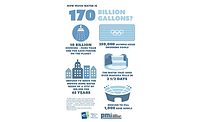Study: Energy-efficiency upgrades could save renters, building owners $3.4 billion annually
Improvements
in the energy efficiency of multifamily buildings could save building owners
and residents up to $3.4 billion nationwide, according to a report released Jan.
26 by CNT Energy and the American Council for an Energy-Efficient Economy.
“Engaging as Partners in Energy Efficiency:
Multifamily Housing and Utilities” demonstrates that energy use in
multifamily buildings can be reduced substantially, and cost-effective upgrades
can result in utility cost savings of 15% to 30% in buildings with five or more
residential units. The key to unlocking the savings, the report finds, is for
energy utilities and apartment building owners to work together more closely to
develop effective energy-efficiency policies.
“We have billions essentially sitting untapped in our apartment buildings. We can harness that by simply setting better policies for efficiency for apartment buildings,” said Anne McKibbin, CNT Energy policy director and coauthor of the report. “Partnering with utilities is a crucial part of the process. Building owners and other housing industry players need to work with their utilities, engaging them directly and in local and state regulatory proceedings.”
Energy-efficiency upgrades improve the bottom line for multifamily building owners, help maintain affordable housing, decrease financial risk for lending institutions and improve occupant comfort. However, building owners often have difficulty finding technical assistance, financing or qualified contractors to upgrade their buildings.
“Maximizing energy efficiency is a win-win for apartment residents, building owners, energy utilities and our energy infrastructure,” said Doug Bibby, president of the National Multi Housing Council. “This report offers excellent ideas that we hope spur further cooperation between multifamily owners and utilities to create a more efficient partnership.”
Better coordination between apartment building owners and energy utilities could address that, according to the report’s analysis. The study finds that there is a vast, largely untapped opportunity to engage utilities in providing effective energy-efficiency programs that target the multifamily sector. The study examines utilities’ involvement in energy efficiency efforts across the country and identifies strategies that the multifamily building community can use to work together for improved efficiency.
The report identifies regions where the multifamily sector could see particularly dramatic benefits from improvements in energy-efficiency policy - Florida, Illinois, Texas and the District of Columbia - regions that have a substantial number of multifamily buildings and energy policies that leave significant room for improvement.
“Utilities and local regulations vary dramatically from state to state and region to region, so there is no one-size-fits-all solution,” says Eric Mackres, ACEEE senior policy analyst. “The common thread is that partnering with the utility is crucial. This report outlines a variety of strategies that can help the multifamily housing sector to engage electric and natural gas utilities in order to expand the resources available for energy efficiency retrofits.”
This report was made possible by support from the John D. & Catherine T. MacArthur Foundation and Living Cities. The full report is available online at aceee.org/research-report/a122. Those interested in learning more are invited to participate in a webinar on Feb. 13 at 1 p.m. CST. For details, go to www.cntenergy.org/calendar or call 773/269-4037.
Source: The American Council for an Energy-Efficient Economy
“We have billions essentially sitting untapped in our apartment buildings. We can harness that by simply setting better policies for efficiency for apartment buildings,” said Anne McKibbin, CNT Energy policy director and coauthor of the report. “Partnering with utilities is a crucial part of the process. Building owners and other housing industry players need to work with their utilities, engaging them directly and in local and state regulatory proceedings.”
Energy-efficiency upgrades improve the bottom line for multifamily building owners, help maintain affordable housing, decrease financial risk for lending institutions and improve occupant comfort. However, building owners often have difficulty finding technical assistance, financing or qualified contractors to upgrade their buildings.
“Maximizing energy efficiency is a win-win for apartment residents, building owners, energy utilities and our energy infrastructure,” said Doug Bibby, president of the National Multi Housing Council. “This report offers excellent ideas that we hope spur further cooperation between multifamily owners and utilities to create a more efficient partnership.”
Better coordination between apartment building owners and energy utilities could address that, according to the report’s analysis. The study finds that there is a vast, largely untapped opportunity to engage utilities in providing effective energy-efficiency programs that target the multifamily sector. The study examines utilities’ involvement in energy efficiency efforts across the country and identifies strategies that the multifamily building community can use to work together for improved efficiency.
The report identifies regions where the multifamily sector could see particularly dramatic benefits from improvements in energy-efficiency policy - Florida, Illinois, Texas and the District of Columbia - regions that have a substantial number of multifamily buildings and energy policies that leave significant room for improvement.
“Utilities and local regulations vary dramatically from state to state and region to region, so there is no one-size-fits-all solution,” says Eric Mackres, ACEEE senior policy analyst. “The common thread is that partnering with the utility is crucial. This report outlines a variety of strategies that can help the multifamily housing sector to engage electric and natural gas utilities in order to expand the resources available for energy efficiency retrofits.”
This report was made possible by support from the John D. & Catherine T. MacArthur Foundation and Living Cities. The full report is available online at aceee.org/research-report/a122. Those interested in learning more are invited to participate in a webinar on Feb. 13 at 1 p.m. CST. For details, go to www.cntenergy.org/calendar or call 773/269-4037.
Source: The American Council for an Energy-Efficient Economy
Looking for a reprint of this article?
From high-res PDFs to custom plaques, order your copy today!






